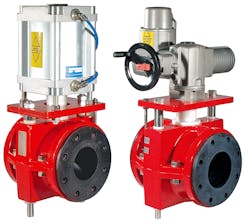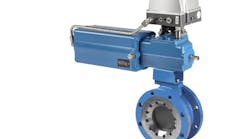It would be impossible to cover all of the mediums that may hamper certain types of valves, so this article focuses on a few mediums that can create operational problems.
One of the reasons certain types of valves have problems with either abrasive or scaling mediums is that the valves have pockets or cavities that allow for material accumulation and hardening in these areas. Another factor that has a negative impact on valves is the use of reduced port valves, which restrict flow and increase velocity. Increased velocity of highly abrasive mediums often leads to abrasive wear on exposed metal or hardened surfaces. Any valve that has structures in the flow stream, such as a butterfly valve that has a disc directly in the middle or slightly offset from the middle, is not ideal for extremely abrasive flow streams.
Lime slurry
One example of a medium that causes problems for valves and instrumentation is lime slurry or often called milk of lime. The reason lime slurry is difficult is that it is both abrasive and has the tendency to scale within pipelines. When mixed with water, lime does not dissolve in solution but rather is a suspended solid.
Often, pipelines with lime slurry are designed with a recirculation loop so that the lime slurry stays in continuous motion to minimize lime particle settling. Even with continuous circulation, lime particles can still settle in void pockets and cavities. For instance, with a ball valve, the valve has an area surrounding the outside of the ball in the valve that fills with material and causes continually rising torque on the valve. Plug valves also have an area around the plug that becomes compacted with material.
Sometimes, ball and plug valves may utilize body cavity fillers, but regardless, the problem still exists where scale builds up on the ball or plug of the valves, causing more difficult operation and often destroys the seats within the valves. Particularly with flow control valves, life of the valves may be severely reduced. In certain cases, the mean time between failure (MTBF) may be only three to six months.
Other difficult mediums
Another issue for many valves is almost anything that is pneumatically conveyed or moved through a dense phase system. Even something as simple as baby powder would be thought to be smooth and easy, but when pneumatically conveyed, the abrasive effects on valves can be devastating. Some very difficult pneumatically conveyed materials are carbon black, cement, fly ash, titanium coke and ore.
Finding the right valve for abrasive, corrosive or scaling mediums
When looking for the right valve for these mediums, start with the following:
- All on-off open-closed valves should be full port design unless for flow control applications.
- Valve design should minimize void or pockets that allow for material accumulation and operational problems later.
- The valve should be self-cleaning.
- Materials of construction should withstand both abrasive and corrosive mediums.
- Manual screw assemblies should be sealed to prevent material accumulation.
Where the pinch valve really shines is that the valve is self-cleaning in scaling substances. When the valve begins to close, the rubber stretches. This stretching helps to start to flake the scaled-on layer. As the valve continues to close, the velocities increase across the sleeve’s elastic sealing surface and help to clear any remaining scale. Since the sleeve has a very smooth inner surface, there is no chance for material to accumulate in pockets or cavities. Simply put, pockets or cavities are nonexistent in pinch valves.
Corrosive mediums
Corrosive mediums may cause significant materials-of-construction requirements for many valves. Of course, materials of construction must be capable to withstand or minimize corrosive mediums. For instance, ball valves, plug valves, diaphragm valves, knife gate valves and butterfly valves all need wetted parts to be able to withstand the corrosive medium. In most cases, depending on the medium, the body material and internal balls, plugs, gates or discs may need to be manufactured out of exotic alloys. Some common alloys would be Monel, Hastelloy, titanium or super-duplex materials. This can increase lead times, and the cost may escalate five to 10 times the standard cost of one of these valves.
With pinch valves in corrosive mediums, there can be many different rubber sleeve materials that can resist corrosive destruction. The rubber sleeve is the only component of the valve that contacts the medium. So, 100% of the remaining valve structure is isolated from the corrosive medium. Examples of different rubber compounds and recommended types of service are shown in Table 1.
Control valves in abrasive mediums
There are many ways to attack abrasive mediums. With control valves, the situation is further exasperated. Control valves are rarely full port, and the port diameter is sized for the proper flow rate, inlet pressure and delta P. When sizing control valves, cavitation and high velocity are enemies of the valve and downstream piping. Sizing is done to minimize the damaging effects.
With abrasive substances, special care of materials must be performed to find a valve that controls the flow accurately and can withstand the abrasive medium. There are two routes to take to improve valve survivability. One is to make internals harder with materials such as Stellite, TMT5, ceramics or others. The other route is to go softer. Rubber lining has been used successfully for years, and the jagged abrasive particles bounce off the elastic surface without damaging the surface.
With coated metallic or ceramic valves, the repair, when needed, is costly. The internals for a 3-inch ceramic valve may cost from $8,000 to $10,000. Coated metallic valves may require extensive rebuilding of the material lost through abrasion and then recoating with hard coatings. This work cannot be done at a plant site and leads to extensive lead times and costly repairs.
With pinch valves, the elastic rubber sleeve can be replaced quickly and cost effectively, usually in less than one hour. The repair cost of repairing a pinch control valve is usually a fraction of repairing a ceramic or hardened metal valve.
Conclusion
All too often, process plants of various types try to use standard valves in abrasive mediums. The result is often less than desirable, and repairs are frequent and costly. The desire for standardization of certain types of valves is admirable and makes tremendous sense for many sites. But it just does not work in every single application. There are certain types of valves that perform very well in certain conditions such as highly corrosive or highly abrasive mediums. A valve that may need to be replaced every three to six months can be improved to years before repairs need to be done.
With pinch valves, the heart of the valve is the rubber sleeve. Rubber can vary tremendously in quality, so be careful when selecting pinch valves. Also, if you have tried a pinch valve with less than optimal performance, then perhaps you just chose the wrong manufacturer. If you face a nagging control valve or on/off valve issue in an abrasive or corrosive medium, you might want to give a high-quality pinch valve a try. (See Figure 3.)
Todd Loudin has been president of Flowrox Inc. North America since 2002. He can be reached at 410-636-2250 extension 115 or [email protected].






